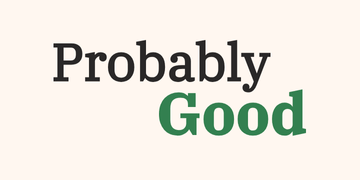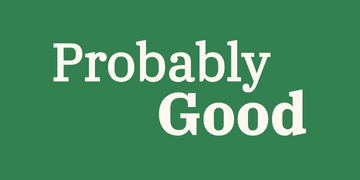Making a meaningful impact
A lot of jobs sound like they’ll do good, but how can you tell if your work would make a meaningful impact on the world?
It’s difficult (and probably not helpful) to assess a specific role’s impact without considering its wider context. To understand the potential impact of a particular job, we need to first assess the goal it will help achieve. This entails zooming in from a general cause area (like global health) and looking at the more specific issues within it (like a particular disease in one region). In other words, what exact problem will this role help solve?
After we clearly define the problem, we can start to assess the problem’s significance. Often, a problem’s significance is the extent to which it causes unhappiness, suffering, or a lower quality of life. It could also incorporate anything that goes against your values (as we talked about in a previous chapter). Simply put, we need to figure out how big a problem is.
While it might seem unintuitive to compare different problems or beneficiaries, we think it’s extremely important. Without thinking critically about problem significance, we could end up investing a lot of time and resources into something that doesn’t make a meaningful impact. And because career decisions could affect our lives for years to come, it’s even more important that the goal we’re pursuing is meaningful.
Let’s say you decide to work with an organization that provides stuffed animals to children in times of emergency. You don’t expect stuffed animals to change the world, but isn’t it a meaningful thing to do anyway?
To push back on your intuition, you do a little investigation and find out about a small town in the U.S.—Newtown, Connecticut—that received 65,000 donated teddy bears in the wake of a tragic school shooting. People wanted to help, and the stuffed animals were intended to comfort those affected. Ultimately, though, these donations became overwhelming. The teddy bears soon outnumbered the actual residents in the town. Thousands sat in a rented storage facility, thousands more were redistributed around the world, and some ended up in an incinerator.

At first, stuffed animals seem to alleviate a big problem; people affected by this tragedy are in need of a lot of help. But upon further reflection, you realize that stuffed animals don’t have a meaningful impact. At best, this organization is working towards solving the problem of lack of toys or comfort—which is much smaller than the other problems at play.
Most problems aren’t bad to work on; we could just make a bigger impact by focusing on larger or more significant ones. When we thoroughly analyze the goals we’re working towards, it helps us find areas where our work could make the greatest impact.
Usually, when we’re working on a larger problem, solving a small part of it could still make a big difference— as it tends to be easier to make an impact in an area where there is a lot of impact to be made. In the next chapter, we’ll look at how well we could help solve the problem. For now, we’ll focus on figuring out problem significance itself.
What is the problem?
When assessing the significance of a problem that a specific role will work on, we need to first define/understand what this problem is.
To illustrate, let’s say you work for a nonprofit that treats depression for low-income women in Uganda. When we assess the exact problem this organization is solving, it is tempting to overgeneralize and say: “We are tackling the global mental health crisis!” This may be true, but in practice, the organization is solving a more specific part of the problem: depression for a particular people group in one region.
This isn’t a downside; it’s often good for organizations to focus and specialize. But when we start assessing problem significance, we need to focus on the part of the problem being solved rather than the entire problem. It’s certainly exciting to think about the biggest relevant problem, but being specific helps us understand the impact we can actually make (and steers us away from roles that only sound impressive or impactful).
There are a lot of ways to think about a problem’s scope and come up with a reasonably narrow definition of it. Some questions to help you gain a better sense include:
- In the best case scenario, how would solving this problem improve the world?
- Who would be helped by solving this problem? How many people/animals are affected by it?
- Does this organization/company tackle an entire problem or one part of it? What part exactly?
Once we’ve defined the problem an organization or intervention will help solve, we can move on to evaluate its significance.
How big is the problem?
It’s great to work on problems that you’re personally connected to or deeply familiar with; this can build motivation and provide some inside knowledge about the issue. Even so, it’s always important to step back and carefully assess the scale of the problem. Without doing so, we could end up making a smaller impact than we might have in a larger problem.
Unsurprisingly, different problems vary greatly in size and significance. Assessing just how big a problem is can seem like an overwhelming task—or at the very least, difficult to do with any precision.
While this can be the case, some big differences are easy to spot. Saving 1000 lives, for example, would make a larger impact than alleviating the burden of disease for 50 people. Even if our estimation turns out to be way off (and we’d actually save only 300 lives) the initial difference between the number of lives impacted is so vast that the first option remains the right choice; having a good estimate helped us see it.
Helpful resources
Whether or not the differences are obvious, there are a lot of tools and information sources to help you. For issues related to Global Health, you could use these extensive charts and interactive maps to understand the prevalence and impact of different diseases, injuries and other health challenges around the world. Other helpful resources include:
- Givewell’s program reviews on different problems & interventions
- Happier Lives Institute’s research on the global burden of mental health issues
- 80,000 Hours’ assessment of various existential and catastrophic risks
- Innovations for Poverty Action’s studies evaluating region-specific problems
- Open Philanthropy’s focus area profiles detailing important cause areas
To look at problem significance from another angle, you could seek out an expert or experienced professional who understands the problem’s current landscape. Of course, any one person (even an expert) may be wrong about some things, but the opinions and thoughts of people who are familiar with the field can be incredibly helpful. Some questions to help you determine a problem’s significance are:
- Are there any estimates of how many people are affected by this condition/problem? Could you point me to them?
- Could solving one problem help solve adjacent problems or lead to impact in other contexts?
- How do people today currently deal with this? What do outcomes usually look like for projects in this domain?
In the process of assessing problem significance, you will probably run up against questions that are more difficult to get a precise or objective answer on. But chances are, a lot of intelligent and thoughtful people have performed research, written opinions, made estimates, and created frameworks for thinking about the problem. Sifting through relevant information may not provide a clear-cut answer, but it can ease the stress of figuring it all out on your own and help you reach a more informed and robust conclusion.
In some cases, it will be difficult to compare the significance of different problems (and we might look to other elements of the SELF framework to help make the final assessment of the roles). But in others, even rough estimates and intuitive assessments can reveal huge differences—equipping us to make a more informed decision.
Summing it up
With problem significance, we’re looking for any information that helps us understand:
- What is the exact problem this role will help solve or improve upon?
- How big is this problem?
Next up in our impact assessment, we’ll look at the efficacy of different methods to solve a problem.

